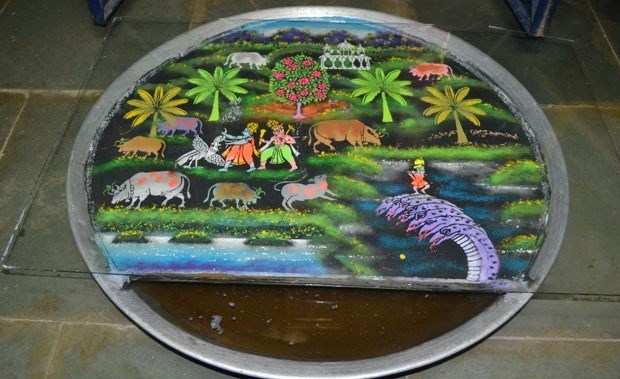"Sanjhi" A Fascinating Ritual
Sanjhi is made from the patripada to amavasya of Ashwin for fifteen days but the preparations starts a day earlier on Bhado Purnima when a square shaped area on a wall is covered with coating of cow dung.
Article by Ashok Mathur
Udaipur has a rich tradition of festivals and rituals which are performed throughout the year. The caravan of festivals start with the onset of Monsoon season and the four months popularly known as ‘chaumasa’ perhaps record the largest number of celebrations.
Of these, some folk customs are really fascinating and one such ritual is called ‘Sanjhi’.

image of water sanjhi ( pani ki sanjhi)
Sanjhi is made from the patripada to amavasya of Ashwin for fifteen days but the preparations starts a day earlier on Bhado Purnima when a square shaped area on a wall is covered with coating of cow dung. This serves as a sort of canvas for the next fifteen days on which new shapes and forms are made in an artistic manner.
Unwed girls fast for these sixteen days of ‘pitrapaksha’ to pray for good match. Every evening they make beautiful images of Sanjhi with cow dung and decorate them with Kaner, Gainda, Rose, Gulbaus and Akda flowers. Other materials used for this purpose include wheat flour, turmeric, kaudi, glass pieces, gota, panni etc.
Figures of peacock, elephant, horse etc. are also made with cow dung or paper. Every evening there are new kinds of figures and decoration with flowers and leaves of various kinds. The figure made on previous day is removed and the used material is collected to immerse in the water at the end of the sixteenth day.
On the first day, parla, on the second vijora, on third day three fans and on the fourth day chaupar is made. On the fifth day five maidens are made and ‘shradhha’ of five bachelor boys is performed.
At some places different things are made like five signs (pachets) big talwar or thal katora, comb and ribbon, moon and sun, mirch bhindi, tumbler and jug, gangasagar and datum, pan-supari, old man and old woman and bandarwar are made. Kilakot is made for the last three days.
Every day Sanjhi is worshipped followed by aarti. All the unmarried girls of the locality participate in it and married women bless them.
On the sixteenth day, all the material used so far is taken to water body and immersed in it. The girl devotees sadly bid farewell for a year to sanjhi by singing farewell songs.
Sanjhi is also made in temples of Udaipur such as Baiji Raj ka Kund, Shrinathji ki Haveli, Goverdhan Nathji and Radhavallabh ji temples with multicolored flowers, fruits and water.
In the evening time a lot of people visit these temples to have a look at the attractive designs. The sanjhi ritual is a curious combination of the prayers for unmarried girls for husbands of their choice, the blessings and affections of their ‘nanad’ and ‘bhojai’ and an artistic expression of fine art.
To join us on Facebook Click Here and Subscribe to UdaipurTimes Broadcast channels on GoogleNews | Telegram | Signal


